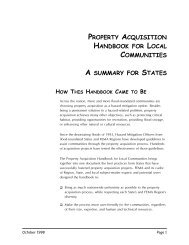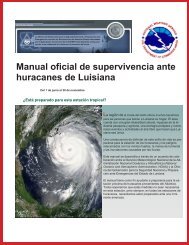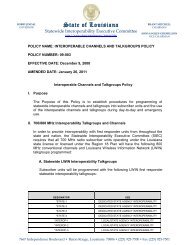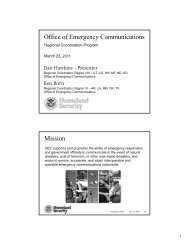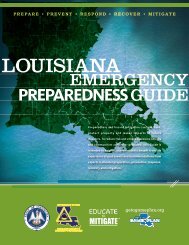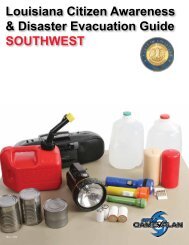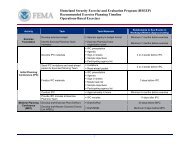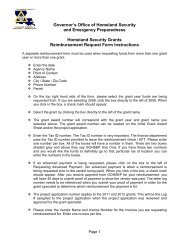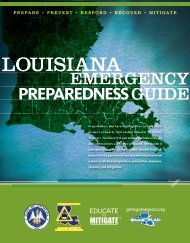Before the Federal Communications Commission Washington, D.C. ...
Before the Federal Communications Commission Washington, D.C. ...
Before the Federal Communications Commission Washington, D.C. ...
- No tags were found...
Create successful ePaper yourself
Turn your PDF publications into a flip-book with our unique Google optimized e-Paper software.
<strong>Federal</strong> <strong>Communications</strong> <strong>Commission</strong> FCC 02-64log all emergency events, including events that are designated for <strong>the</strong> geographic area for which <strong>the</strong>decoder is programmed, could degrade <strong>the</strong> system’s ability to deliver emergency information to decoderlocations near or adjacent to areas directly impacted. However, we conclude that it is more consistentwith <strong>the</strong> voluntary nature of state and local EAS to allow broadcast stations and cable systems to choosewhich state and local EAS messages <strong>the</strong>y wish to display and log. We are confident that EASparticipants will exercise good judgement in making <strong>the</strong>se choices. Broadcast stations and cable systemsmay upgrade <strong>the</strong>ir existing EAS equipment to include <strong>the</strong> selective displaying and logging capability onan optional basis until <strong>the</strong> equipment is replaced. All existing and new models of EAS equipmentmanufactured after August 1, 2003 must be capable of selectively displaying and logging messages withstate and local event codes. Broadcast stations and cable systems which replace <strong>the</strong>ir EAS equipmentafter February 1, 2004 must install EAS equipment that is capable of selectively displaying and loggingEAS messages with state and local event codes. We emphasize that this selective displaying and loggingfeature applies only to state and local events. EAS equipment must continue to display and log allnational EAS messages and all required weekly and monthly tests.2. Equipment Authorization Requirements46. As explained above, we have decided not to adopt <strong>the</strong> alternative suggestion set forth in<strong>the</strong> NPRM to leave <strong>the</strong> development of event codes and location codes to state and local authorities.However, we will amend <strong>the</strong> rules to provide that any modifications to existing authorized EASequipment that are necessary to implement revisions in EAS codes or to implement <strong>the</strong> selectivedisplaying and logging feature for state and local events are Class I permissive changes that do notrequire a new application for and grant of equipment certification. We believe that this amendment willprovide equipment manufacturers more flexibility in <strong>the</strong> design and modification of EAS equipment.47. Fur<strong>the</strong>rmore, as discussed above, we are amending Part 11 to require that all existing andnew models of EAS equipment manufactured after August 1, 2003 be capable of transmitting andreceiving <strong>the</strong> new event and location codes adopted in this Report and Order. Similarly, we areamending Part 11 to require that all existing and new models of EAS equipment manufactured afterAugust 1, 2003 be capable of selectively displaying and logging messages with state and local eventcodes.C. EAS Testing48. Current Part 11 rules require broadcast stations and cable systems to retransmit <strong>the</strong>Required Monthly Test (“RMT”) within 15 minutes of receipt of <strong>the</strong> RMT message. 109 In <strong>the</strong> NPRM, weproposed to amend Part 11 to increase <strong>the</strong> time for retransmitting RMTs to 60 minutes from <strong>the</strong> time ofreceipt of <strong>the</strong> RMTs. 110 We tentatively concluded that a longer relay window for RMTs would easescheduling difficulties for all EAS participants without negatively affecting EAS test procedures.49. Commenters overwhelmingly support increasing <strong>the</strong> relay window to 60 minutes, notingthat it will provide additional flexibility to insert <strong>the</strong> RMT message into <strong>the</strong> program schedule withoutdisruption. 111 Only one commenter opposes this proposal, arguing that a 60-minute relay window would109110See 47 C.F.R. §§ 11.51(l), 11.52(e)(2) and 11.61(a)(1)(v).NPRM, 16 FCC Rcd at 7262.111NAB Comments at 6; NCTA Comments at 8; Named StBAs Comments at 13-14; WSAB/WA SECCComments at 12; Cox Comments at 7; Ohio EMA Comments at 4; Salem Comments at 1-2; Gorman Comments at 2.20




